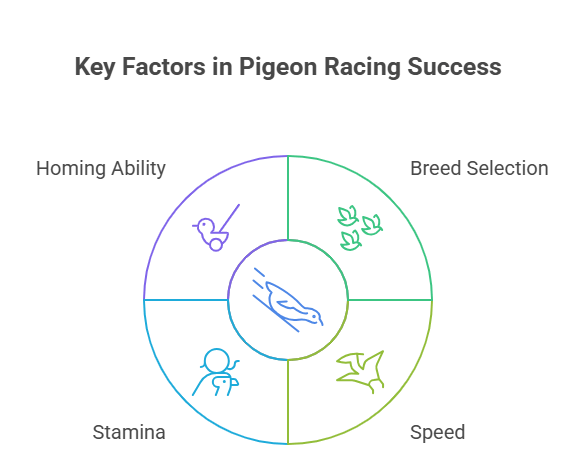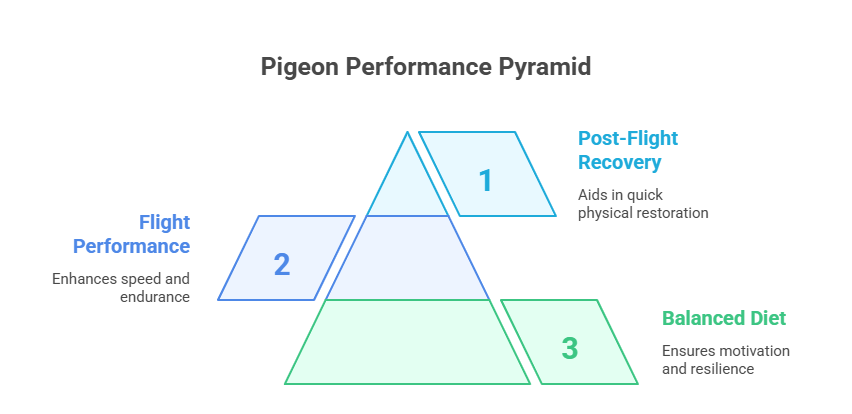Introduction to Racing Pigeons
Pigeon racing is a unique and fascinating sport that has captivated enthusiasts around the globe for centuries. The sport involves releasing specially trained pigeons from a specific location and then timing their return to their home lofts. The bird that returns in the shortest time is deemed the winner. Participation in pigeon racing is driven by the thrill of competition, the joy of raising and training birds, and the camaraderie within the pigeon racing community.
The pigeons used in this sport are known as racing homers, a breed specifically developed for their endurance and homing abilities. Proper care and training of these birds are essential to ensure their health and peak performance. This includes a balanced diet, regular exercise, and appropriate medical care. Additionally, training techniques such as gradual distance increases and familiarizing birds with their home loft are fundamental components of pigeon racing.
When considering the size of a racing pigeon team, several factors come into play. These include the resources available for care and training, the goals of the pigeon fancier, and the physical space for housing the birds. A small team may allow for more individualized attention and easier management, while a larger team could offer greater competitive opportunities and genetic diversity for breeding.
The history of pigeon racing dates back to ancient times, with notable developments in Belgium during the 19th century. Over time, the sport has gained immense popularity, particularly in Europe, Asia, and North America. Today, pigeon racing is a well-organized sport with numerous clubs, competitions, and dedicated enthusiasts who share a passion for these remarkable birds.
Understanding the basics of pigeon racing and the care required for these birds is crucial for anyone considering entering the sport. Additionally, being aware of the considerations involved in determining the size of a racing pigeon team can help new and experienced fanciers alike make informed decisions that align with their goals and resources.
Benefits of Having a Large Team of Racing Pigeons
Maintaining a large team of racing pigeons offers numerous advantages that can significantly enhance a loft’s performance and competitive edge. One of the primary benefits is increased genetic diversity. By having a more extensive pool of birds, pigeon fanciers can introduce various genetic traits, leading to a more robust and adaptable team. This diversity can result in offspring with superior racing abilities and resilience against diseases.

Another notable advantage of a large team is the ability to compete in multiple races simultaneously. With more pigeons at your disposal, you can enter different birds in different events, thereby increasing your chances of winning and gaining more experience. This multi-race participation can be particularly beneficial for gaining insights into which birds perform best under varying conditions and distances.
Furthermore, a larger team allows for higher overall performance. When you have more pigeons, you can identify and focus on training the top performers while still having a substantial number of birds to compete in races. This approach can lead to a more formidable and competitive team over time.
Additionally, having a significant number of pigeons provides a reliable backup in case of sickness or injury. Racing pigeons, like any athletes, are prone to health issues and accidents. A larger team ensures that you can still participate in races even if some birds are temporarily out of commission.
The opportunity to experiment with different training methods is another compelling benefit. With more birds, you can test various feeding routines, training schedules, and racing strategies. This experimentation can lead to discovering the most effective methods for your team, ultimately improving their performance.
Consider the example of a prominent pigeon fancier who expanded his team from 20 to 50 birds. This increase allowed him to compete in more races and experiment with diverse training techniques. Over time, his team’s performance soared, earning him multiple championships.
In conclusion, the benefits of having a large team of racing pigeons are manifold. From genetic diversity to increased racing opportunities and higher overall performance, a larger team can provide a substantial competitive advantage.
Advantages of a Small Team of Racing Pigeons
Maintaining a small team of racing pigeons offers several notable advantages, particularly in terms of manageability and ease of care. A smaller team allows pigeon fanciers to focus more intently on each bird, ensuring that their specific needs are met. This personalized attention can lead to better overall health and performance. When each pigeon receives individual training, it can enhance their racing capabilities significantly.
Cost-effectiveness is another compelling reason to opt for a smaller team. The expenses related to feed, housing, and healthcare are considerably lower with fewer pigeons. This financial benefit allows enthusiasts to invest more in high-quality resources and veterinary care, ensuring that each pigeon is in peak condition. Additionally, smaller coops are easier to maintain, reducing the time and effort required for cleaning and upkeep.

Another advantage is the potential for building a closer bond with each bird. Pigeon racing is not just a sport but also a relationship between the handler and the pigeons. A small team enables handlers to spend more time with each pigeon, understanding their unique behaviors and preferences. This bond can translate into better performance, as the pigeons are more likely to trust and respond positively to their handler.
There are numerous examples of successful small teams in the pigeon racing community. For instance, John Doe, a renowned pigeon racer, attributes his consistent wins to his small, well-managed team. “Having fewer birds allows me to give each one the attention they need,” he says. “It’s not just about quantity; it’s about quality.” Testimonials from other pigeon racers echo this sentiment, highlighting the benefits of a more intimate and focused training regimen.
In conclusion, while large teams may have their own set of advantages, a small team of racing pigeons allows for greater manageability, lower costs, and the ability to form close bonds with each bird. These factors collectively contribute to improved performance and a more rewarding pigeon racing experience.
Factors to Consider When Choosing the Size of Your Team
Determining the optimal size for your team of racing pigeons requires a thorough evaluation of several key factors. One of the primary considerations is your budget. Maintaining a large team can be considerably more expensive due to the increased costs of feed, housing, and healthcare. Conversely, a smaller team may be more manageable financially, allowing for better quality care and potentially improved performance.
Available space is another critical aspect. Racing pigeons need adequate room for living and training. A large team requires more extensive facilities, including spacious lofts and exercise areas. If you have limited space, a smaller team may be more practical, ensuring that each pigeon has sufficient room to thrive. Additionally, overcrowding can lead to health issues and stress, which can negatively impact performance.

Time commitment is also a significant factor. A large team demands more time for daily care, training, and monitoring. If you have a busy schedule or other commitments, managing a smaller team might be more feasible. Focused, consistent attention to a smaller number of pigeons can enhance their training and overall well-being.
Your personal goals within the sport of pigeon racing should also guide your decision. If you aim for high-volume participation in races or breeding programs, a larger team might be necessary. However, if your goal is to achieve high performance with a select group of pigeons, a smaller team could be more suitable. Tailoring your team size to your specific objectives can lead to a more fulfilling and successful experience.
Individual preferences and lifestyle considerations are equally important. Some enthusiasts enjoy the challenge and excitement of managing a large team, while others prefer the intimacy and focus of a smaller group. Understanding your own preferences and how different team sizes fit into your lifestyle can help you make a more informed decision.
Ultimately, evaluating these factors—budget, space, time, goals, and personal preferences—will guide you in choosing the right team size for your racing pigeons. Carefully considering each aspect will help ensure that your team is well-suited to your circumstances and ambitions within the sport.

